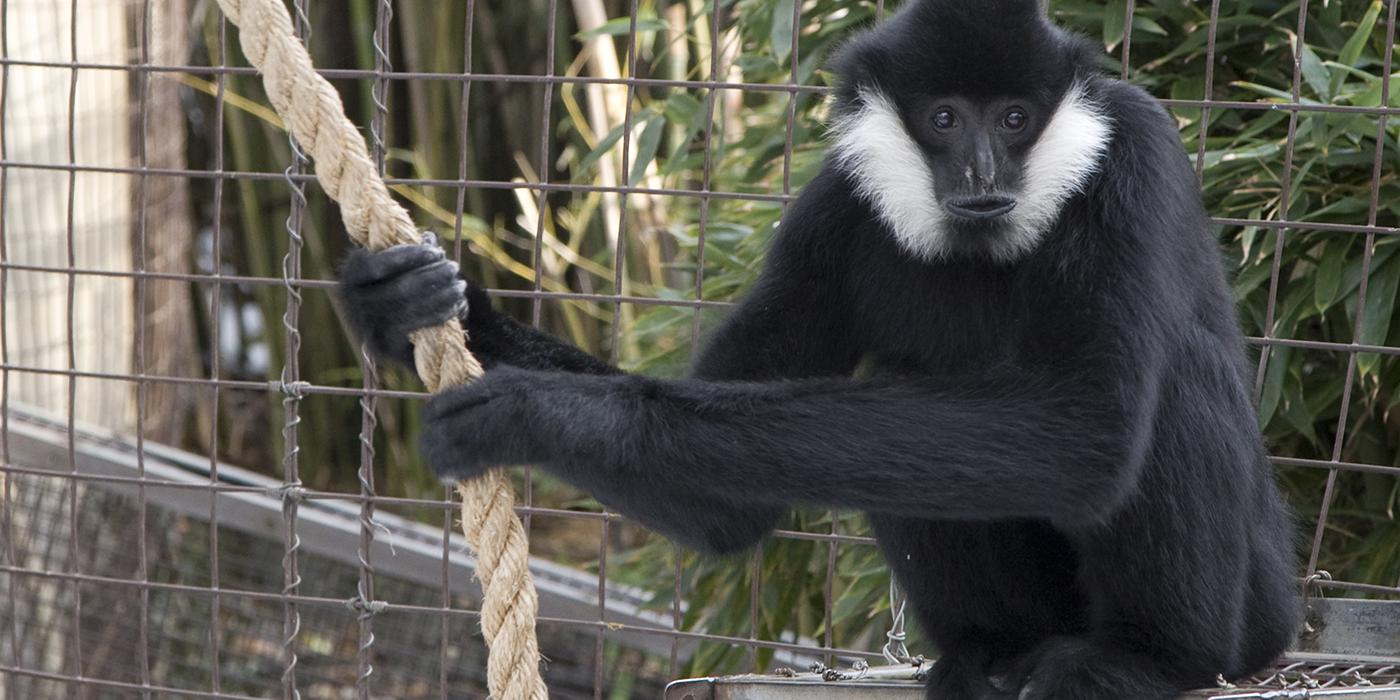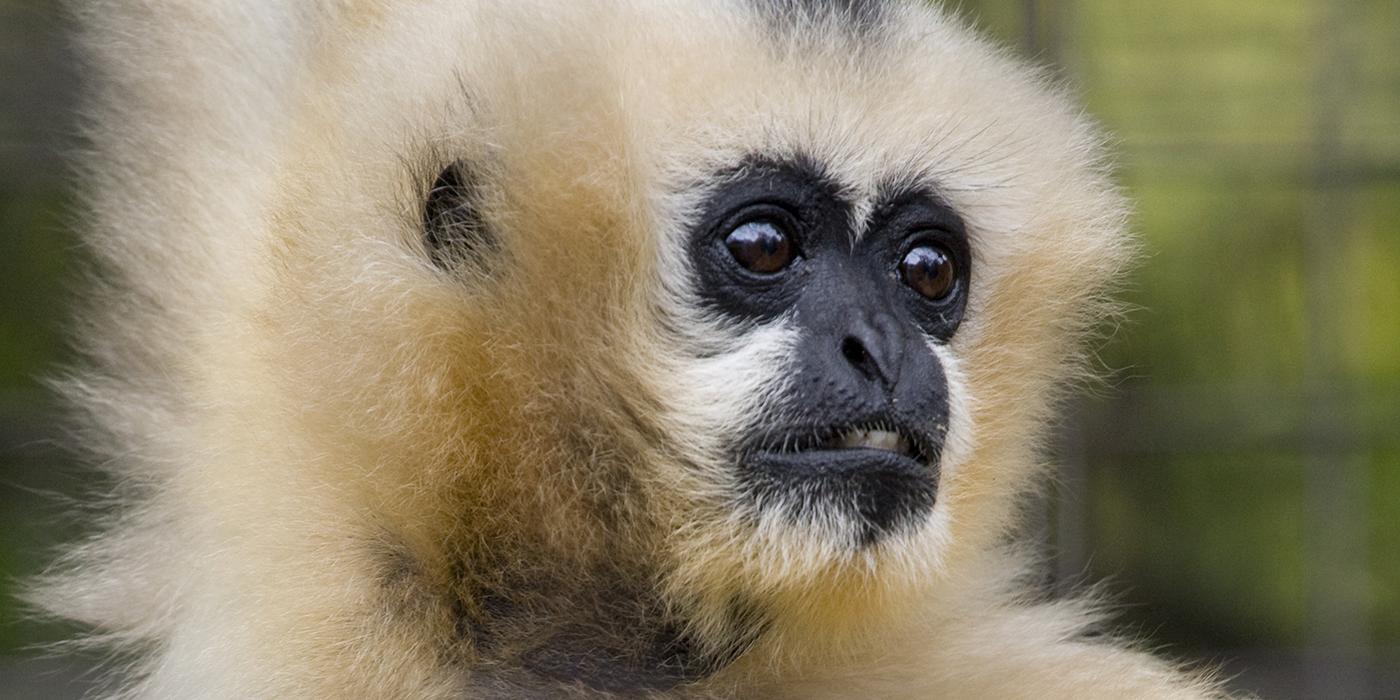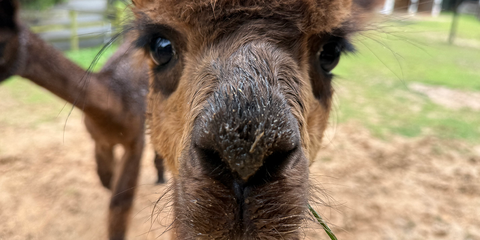Physical Description
White-cheeked gibbons' appearance varies by age and with sex. All infants are a beige color. By the time they are a year to a year and a half old, their coats have become black with white cheek patches. At sexual maturity (five to seven years), males remain black and females turn a beige color again.
The external genitalia of males and females are remarkably similar, and the sex of an individual can be hard to determine without close examination. Both sexes have long, dagger-like canines.
Size
White-cheeked gibbons are 18 to 25 inches (47 to 64 centimeters) tall and weigh about 15 to 20 pounds (7 to 9 kilograms).
Native Habitat
White-cheeked gibbons live in Laos, Vietnam and southern China. They live in evergreen tropical rainforests and monsoon forests. Their home range is about 75 to 100 acres (0.3 to 0.4 square kilometers), and they travel about 1 mile (1.6 kilometers) per day through this range.
They defend about three-quarters of their range as their group territory. Defense takes the form of calls from the center of the territory, calls from the boundaries, confrontations across the boundaries, chasing across the boundaries and, rarely, physical contact between males.
Gibbons are arboreal and spend most of their time in the canopy. They rarely stay on the ground for very long, but here at the Smithsonian's National Zoo, the gibbons often prefer to spend more time on the ground.
Communication
Vocalization is a major social investment. The basic pattern is an introductory sequence where both males and females "warm up," followed by alternating sequences of male and female calls and of female great calls, usually with a male coda at the end. Calls are often accompanied by behavioral acrobatics.
Food/Eating Habits
White-cheeked gibbons eat mostly ripe fruits, leaves and a small amount of invertebrates. When eating, they spend 65 percent of their time eating fruit and 35 percent of their time eating young leaves. They move and feed mainly in the upper and middle levels of the canopy and almost never come down to the ground. Families often feed together in the trees.
At the Zoo, each group is fed a mixture of kale, cabbage, green beans, carrots, apples, bananas, sweet potatoes, primate chow and a "vegetable of the day" multiple times a day. Amounts depend on the composition of each group. Each animal receives a cooked egg once a week.
Social Structure
Like all gibbons, white-cheeked gibbons live in flexible social groups, typically comprised of an adult pair with offspring. They are physically independent at about three years old, mature at about six, and usually leave the family group at about eight, though they may spend up to ten years in their family groups. Gibbons exhibit co-dominance, with females often playing a larger role in food acquisition. Grooming is an important social activity between individuals. Infant-centered play behavior is another common social activity.
Reproduction and Development
The menstrual cycle is 28 days, and gestation lasts seven months. White-cheeked gibbons give birth to a single offspring every two or three years. Infants cling to their mothers from birth. Newborns are often found clinging horizontally across their mothers' abdomens. This allows the mothers to sit with their knees up, as most gibbons do.
Older infants orient vertically on the abdomen. Youngsters are weaned early in their second year. Once the offspring reach full maturity, they usually leave the family group and search for a territory and mate of their own.
Conservation Efforts
White-cheeked gibbons are critically endangered. Their numbers have declined by 80 percent or more over the past 45 years, primarily due to habitat loss and poaching.
One of the most serious threats to gibbon viability is the unsustainable practice of timber extraction in Indonesia and southeast Asia. Habitat destruction and the subsequent degradation, either from commercial timber harvesting or conversion of land to agriculture (particularly palm oil), poses a very serious threat to these arboreal apes. Moreover, the illegal pet trade is booming in Southeast Asia and infant apes are very popular pets.
The Association of Zoos and Aquariums' Ape Taxon Advisory Group (AZA Ape TAG) has supported conservation initiatives such as anti-poaching patrols and law enforcement, additional research and support from zoos, improved management of protected areas and support of sanctuaries, and increased community involvement to help protect apes.
Recognizing the growing threat of unsustainably grown palm oil, in early 2014, the Association of Zoos and Aquariums (AZA) assembled a multi-institutional task force to examine issues related to palm oil production and to develop an AZA position statement. In September 2014, the board of the AZA adopted an official position on palm oil. After adopting this position, the AZA then joined the Round Table on Sustainable Palm Oil (RSPO) in order to represent the views of its member institutions with key stakeholder in the palm oil industry and to advocate for environmentally sustainable production.Help this Species
- Reduce, reuse and recycle — in that order! Cut back on single-use goods, and find creative ways to reuse products at the end of their life cycle. Choose recycling over trash when possible.
- Be a smart consumer. Choose products made with sustainable ingredients, such as Smithsonian certified Bird Friendly coffees, which support farmers striving to limit their impact on wildlife and habitat.
- Practice ecotourism by being an advocate for the environment when you’re on vacation. During your travels, support, visit or volunteer with organizations that protect wildlife. Shop smart too! Avoid buying products made from animals, which could support poaching and the illegal wildlife trade.
- Share the story of this animal with others. Simply raising awareness about this species can contribute to its overall protection.





